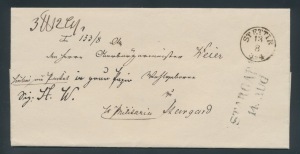Philately is the study and collecting of postage stamps. But mail carriage existed for over a thousand years before the first postage stamp was issued and through the history of our hobby many collectors have ventured back to collect these postal artifacts. These earliest letters that were carried are lost to us and probably were official, military and merchants correspondences. The Vatican maintains an enormous record of over 1500 years of official church correspondence. The model for this was probably similar to all of the earliest mail. Nearly all was carried by church carriers who travelled from diocese to diocese keeping the far flung offices in communication with each other. The political arms of most countries did the same as did the military, and after the early Middle Ages so did the growing merchant class. About 1300 it dawned on people that having numerous entities all carrying mail between the same basic places was a bit redundant and certain merchant houses began to carry mail for others for a fee. Throughout the later Middle Ages postal service was largely a private enterprise (a wonderful novel which concerns this is Thomas Pynchon’s The Crying of lot 49.)
The history of postal service in the late Middle Ages, Renaissance and early modern period is the story of privatization turning to publicazation. People found that private carriers only wanted to run profitable routes, leaving smaller towns bereft of service. Private carriers merged and acquired each other so as to create monopolies so that they could raise prices. And private companies could favor one letter over another, leaving many merchants at a competitive disadvantage relative to others.(Remember in all the “privatization” discussions that we have today about government services that nearly all these services were once private and that they either became public or became regulated by the public because of egregious abuses.) As postal services became more sophisticated and business like, records of postage rates paid were kept and letters need to be marked indicating where they were posted, the amount of postage that carriage would cost, and whether that postage was paid or not.
It is these markings on envelopes that collectors collect when they collect stampless covers. The field is vast, and the catalogs that exist (particularly The American Stampless Cover catalog) while thorough and well researched, are no match for the authority of the general stamp catalogs. In fifty years, I have never found a postage stamp, within the schema that Scott lists, that wasn’t in the Scott catalog. One finds new towns and styles of handstamps and rate markings on stampless covers with some frequency. Postmasters were allowed to design their own canceling devices and the ability to discover a unique or unlisted item for a few dollars is one of the appeals to collectors of this area.
Stampless cover collecting exists for all countries that were educated and had commerce before 1850. Most people in this country collect only United States stampless covers and most do it by state. Stampless covers have always been sort of like a poor relative to traditional philately. For many years before the internet, the search for smaller towns was intriguing. But search engines have made this collecting much easier. Until about 1930 very few people collected stampless covers. For the next forty years they gained a bit of popularity, especially when stamp prices surged. They were seen as a moderately priced alternative to stamps. In the last thirty years they still have their devotees but the vast majority of different stampless cover types can still be had for a couple dollars each. This a great area for nosy people to collect. In the United states before 1850, postage rates were by distance and number of sheets of paper. An envelope counted as a separate sheet of paper meaning that any letter with an envelope counted at double rate. People therefore used large sheets of paper. They wrote on one side and folded the paper on itself to create an address side. These are what we now call folded letters. This means that all this correspondence came down to us with postal markings and the gossip of the day intact. And as we are probably the last generation that will be able to read cursive writing this is a wonderful window to the worries, joys and concerns of our great great great grandparents.

